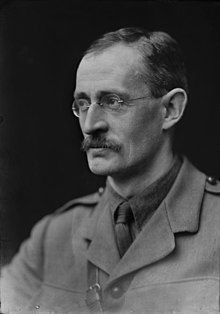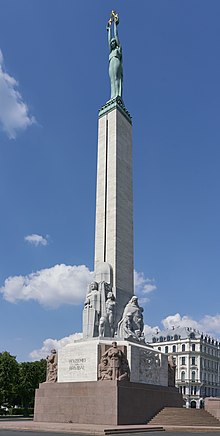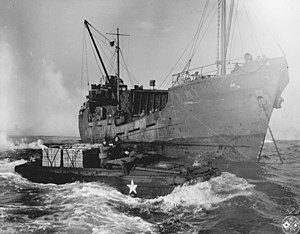Portal:History
The History Portal
History (derived from Ancient Greek ἱστορία (historía) 'inquiry; knowledge acquired by investigation') is the systematic study and documentation of human past. History is an academic discipline which uses a narrative to describe, examine, question, and analyze past events, and investigate their patterns of cause and effect. Historians debate which narrative best explains an event, as well as the significance of different causes and effects. Historians debate the nature of history as an end in itself, and its usefulness in giving perspective on the problems of the present.
The period of events before the invention of writing systems is considered prehistory. "History" is an umbrella term comprising past events as well as the memory, discovery, collection, organization, presentation, and interpretation of these events. Historians seek knowledge of the past using historical sources such as written documents, oral accounts or traditional oral histories, art and material artifacts, and ecological markers. History is incomplete and still has debatable mysteries.
Stories common to a particular culture, but not supported by external sources (such as the tales surrounding King Arthur), are usually classified as cultural heritage or legends. History differs from myth in that it is supported by verifiable evidence. However, ancient cultural influences have helped create variant interpretations of the nature of history, which have evolved over the centuries and continue to change today. The modern study of history is wide-ranging, and includes the study of specific regions and certain topical or thematic elements of historical investigation. History is taught as a part of primary and secondary education, and the academic study of history is a major discipline in universities.
Herodotus, a 5th-century BCE Greek historian, is often considered the "father of history", as one of the first historians in the Western tradition, though he has been criticized as the "father of lies". Along with his contemporary Thucydides, he helped form the foundations for the modern study of past events and societies. Their works continue to be read today, and the gap between the culture-focused Herodotus and the military-focused Thucydides remains a point of contention or approach in modern historical writing. In East Asia a state chronicle, the Spring and Autumn Annals, was reputed to date from as early as 722 BCE, though only 2nd-century BCE texts have survived. The title "father of history" has also been attributed, in their respective societies, to Sima Qian and Ibn Khaldun. (Full article...)

Sir William Beach Thomas, KBE (22 May 1868 – 12 May 1957) was a British author and journalist known for his work as a war correspondent and his writings about nature and country life.
Thomas was the son of a clergyman in Cambridgeshire. He was educated at Shrewsbury School and Christ Church, Oxford, before he embarked on a short-lived career as a schoolmaster. Finding that work unpleasant, he turned his attention to writing articles for newspapers and periodicals and began to write books. (Full article...)

American services and supply played a crucial part in the World War II Siegfried Line campaign, which ran from the end of the pursuit of the German armies from Normandy in mid-September 1944 until December 1944, when the American forces were engulfed by the German Ardennes offensive. In August 1944, the Supreme Allied Commander, General Dwight D. Eisenhower, elected to continue the pursuit of the retreating German forces beyond the Seine and across France and Belgium to the German border instead of pausing to build up supplies and establish the line of communications as called for in the original Operation Overlord plan. The subsequent advance to the German border stretched the American logistical system to breaking point, and the advance came to a halt in mid-September.
Problems with port capacity and transportation created many shortages, but many others were the result of mismanagement and underestimating requirements. A critical shortage of winter clothing developed from a reluctance to accept new items and a failure to order adequate quantities in the mistaken belief that the war would end before they were required. The winter of 1944–1945 in Northwest Europe was unusually cold and wet, and American soldiers were not trained in how to avoid cold injury. The American forces suffered 71,000 casualties from trench foot and frostbite. (Full article...)

The Freedom Monument (Latvian: Brīvības piemineklis) is a monument located in Riga, Latvia, honouring soldiers killed during the Latvian War of Independence (1918–1920). It is considered an important symbol of the freedom, independence, and sovereignty of Latvia. Unveiled in 1935, the 42-metre (138 ft) high monument of granite, travertine, and copper often serves as the focal point of public gatherings and official ceremonies in Riga.
The sculptures and bas-reliefs of the monument, arranged in thirteen groups, depict Latvian culture and history. The core of the monument is composed of tetragonal shapes on top of each other, decreasing in size towards the top, completed by a 19-metre (62 ft) high travertine column bearing the copper figure of Liberty lifting three gilded stars. The concept for the monument first emerged in the early 1920s when the Latvian prime minister, Zigfrīds Anna Meierovics, ordered rules to be drawn up for a contest for designs of a "memorial column". After several contests the monument was finally built at the beginning of the 1930s according to the scheme "Mirdzi kā zvaigzne!" ("Shine like a star!") submitted by Latvian sculptor Kārlis Zāle. Construction works were financed by private donations. (Full article...)
T3 was a sea-going torpedo boat that was operated by the Royal Yugoslav Navy between 1921 and 1941. Originally 78 T, a 250t-class torpedo boat of the Austro-Hungarian Navy built in 1914, she was armed with two 66 mm (2.6 in) guns, four 450 mm (17.7 in) torpedo tubes, and could carry 10–12 naval mines. She saw active service during World War I, performing convoy, escort and minesweeping tasks, anti-submarine operations and shore bombardment missions. In 1917 the suffixes of all Austro-Hungarian torpedo boats were removed, and thereafter she was referred to as 78. She was part of the escort force for the Austro-Hungarian dreadnought Szent István during the action that resulted in the sinking of that ship by Italian torpedo boats in June 1918.
Following Austria-Hungary's defeat in 1918, she was allocated to the Navy of the Kingdom of Serbs, Croats and Slovenes, which later became the Royal Yugoslav Navy, and was renamed T3. At the time, she and the seven other 250t-class boats were the only modern sea-going vessels of the fledgling maritime force. During the interwar period, T3 and the rest of the navy were involved in training exercises and cruises to friendly ports, but activity was limited by reduced naval budgets. The ship was captured by the Italians during the Axis invasion of Yugoslavia in April 1941. After her main armament was modernised and her crew increased to 62, she served with the Royal Italian Navy under her Yugoslav designation, although she was only used for coastal and second-line tasks. Following the Italian capitulation in September 1943, she was captured by Germany and, after being fitted with additional anti-aircraft guns, served with the German Navy or the Navy of the Independent State of Croatia as TA48. In German/Croatian service her crew of 52 consisted entirely of Croatian officers and enlisted men. She was sunk by Allied aircraft in February 1945 while in the port of Trieste, where she had been built. (Full article...)
SMS Lothringen was the last of five pre-dreadnought battleships of the Braunschweig class, built for the German Kaiserliche Marine (Imperial Navy). She was laid down in December 1902, was launched in May 1904, and was commissioned in May 1906. She was named for Lothringen (now Lorraine), a province of the German Empire from 1871 to 1918. The ship was armed with a battery of four 28 cm (11 in) guns and had a top speed of 18 knots (33 km/h; 21 mph). Like all other pre-dreadnoughts built around the turn of the century, Lothringen was quickly made obsolete by the launching of the revolutionary HMS Dreadnought in December 1906; as a result, her career as a front-line battleship was cut short.
Lothringen's peacetime career centered on squadron and fleet exercises and training cruises with II Battle Squadron. Scheduled to be withdrawn from service in July 1914 and replaced by newer dreadnought battleships, the outbreak of World War I that month prevented her retirement. She spent the first two years of the war primarily serving as a guard ship in the German Bight. She and the rest of II Squadron joined the dreadnoughts of the High Seas Fleet to support the raid on Scarborough, Hartlepool, and Whitby in December 1914. In poor condition by 1916, she was withdrawn from fleet service in February. She thereafter patrolled the Danish straits until she was replaced by the battleship Hannover in September 1917. She spent the rest of the war as a disarmed training ship. (Full article...)
USS Princess Matoika (ID-2290) was a transport ship for the United States Navy during World War I. Before the war, she was a Barbarossa-class ocean liner that sailed as SS Kiautschou for the Hamburg America Line and as SS Princess Alice (sometimes spelled Prinzess Alice) for North German Lloyd. After the war she served as the United States Army transport ship USAT Princess Matoika. In post-war civilian service she was SS Princess Matoika until 1922, SS President Arthur until 1927, and SS City of Honolulu until she was scrapped in 1933.
Built in 1900 for the German Far East mail routes, SS Kiautschou traveled between Hamburg and Far East ports for most of her Hamburg America Line career. In 1904, she was traded to competitor North German Lloyd for five freighters, and renamed SS Princess Alice. She sailed both transatlantic and Far East mail routes until the outbreak of World War I, when she was interned in the neutral port of Cebu in the Philippines. Seized by the U.S. in 1917, the newly renamed USS Princess Matoika carried thousands of U.S. troops to and from France in U.S. Navy service from 1918 to 1919. As an Army transport after that, she continued to return troops and repatriated the remains of Americans killed overseas in the war. In July 1920 she was a last-minute substitute to carry a large portion of the United States team to the 1920 Summer Olympics in Antwerp. From the perspective of the Olympic team, the trip was disastrous and a majority of the team members published a list of grievances and demands of the American Olympic Committee in an action known today as the Mutiny of the Matoika. (Full article...)
The Maryland and Virginia Rifle Regiment, most commonly known as Rawlings' Regiment in period documents, was organized in June 1776 as a specialized light infantry unit of riflemen in the Continental Army during the American Revolutionary War. The American rifle units complemented the predominant, musket-equipped, line infantry forces of the war with their long-range marksmanship capability and were typically deployed with the line infantry as forward skirmishers and flanking elements. Scouting, escort, and outpost duties were also routine. The rifle units' battle formation was not nearly as structured as that of the line infantry units, which employed short-range massed firing in ordered linear formations. The riflemen could therefore respond with more adaptability to changing battle conditions.
The Maryland and Virginia Rifle Regiment consisted of nine companies—four from Maryland and five from Virginia. The two-state composition of the new unit precluded it from being managed through a single state government, and it was therefore directly responsible to national authority as an Extra Continental regiment. (Full article...)
The Battle of Arras (also known as the Second Battle of Arras) was a British offensive on the Western Front during the First World War. From 9 April to 16 May 1917, British troops attacked German defences near the French city of Arras on the Western Front. The British achieved the longest advance since trench warfare had begun, surpassing the record set by the French Sixth Army on 1 July 1916. The British advance slowed in the next few days and the German defence recovered. The battle became a costly stalemate for both sides and by the end of the battle, the British Third Army and the First Army had suffered about 160,000 casualties and the German 6th Army about 125,000.
For much of the war, the opposing armies on the Western Front were at stalemate, with a continuous line of trenches from the Belgian coast to the Swiss border. The Allied objective from early 1915 was to break through the German defences into the open ground beyond and engage the numerically inferior German Army (Westheer) in a war of movement. The British attack at Arras was part of the Anglo-French Nivelle Offensive, the main part of which was the Second Battle of the Aisne 50 mi (80 km) to the south. The aim of the French offensive was to break through the German defences in forty-eight hours. At Arras the Canadians were to capture Vimy Ridge, dominating the Douai Plain to the east, advance towards Cambrai and divert German reserves from the French front. (Full article...)
Harry S. Truman (May 8, 1884 – December 26, 1972) was the 33rd president of the United States, serving from 1945 to 1953. A member of the Democratic Party, he served as a United States senator from Missouri from 1935 to 1945 and briefly in 1945 as the 34th vice president
under Franklin D. Roosevelt. Assuming the presidency after Roosevelt's death, Truman implemented the Marshall Plan in the wake of World War II to rebuild the economy of Western Europe and established both the Truman Doctrine and NATO to contain the expansion of Soviet communism. He proposed numerous liberal domestic reforms, but few were enacted by the conservative coalition that dominated Congress.
Truman was raised in Independence, Missouri, and during World War I fought in France as a captain in the Field Artillery. Returning home, he opened a haberdashery in Kansas City, Missouri, and was elected as a judge of Jackson County in 1922. Truman was elected to the United States Senate from Missouri in 1934. Between 1940 and 1944, he gained national prominence as chairman of the Truman Committee, which was aimed at reducing waste and inefficiency in wartime contracts. (Full article...)












































